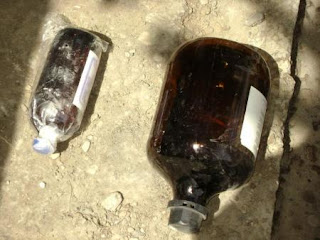The conversion of raw opium to pure heroin can be broken down into four parts — purification of raw opium, extraction of morphine from opium, conversion of morphine to heroin base and purification of heroin base and conversion to hydrochloride salt. After step 4, diluents and adulterants may be added either by the
manufacturer or by parties further along the distribution chain.
Purification of Opium
Raw opium collected from the poppy is placed in an
open cooking pot of boiling water. This should dissolve all of the
alkaloids in the opium, and allow any solid plant material, to float to the top of the solution. Solid
impurities are scooped out or filtered by straining the mixture though
cheesecloth or burlap. The liquid is then re-heated over a low flame,
evaporating the water to leave behind a thick, dark paste, which is then
dried in the sun. The opium left behind has a putty-like consistency and
is generally about 20% lighter (20% more pure) than the raw material.
Extraction of Morphine
Processed opium is stirred in a large drum of boiling water until it has
completely dissolved. Calcium hydroxide is then
added to the solution, this has the effect of converting morphine,
insoluble in cool water, into the soluble salt, calcium morphenate. When the mixture is
cooled, the morphenate remains in solution, while the other chemicals
settle to form a brown sludge at the bottom of the container. The calcium morphenate is scooped from the
drum and filtered. The filtered solution is re-heated, but
not boiled, and ammonium chloride is added. After the solution is cooled, morphine base settles to the bottom
of the pot. The solution is then poured off through cloth filters,
leaving chunks of morphine base on the cloth, which are set aside to dry further in the sun.
Conversion of Morphine to Heroin Base
The key chemical used to form heroin is
acetic anhydride. Morphine base is mixed with acetic anhydride in a stainless steel/enamel pot. The pot lid is
tied or clamped on with a damp towel for a gasket, and the mixture is heated, avoiding boiling. The cooking proceeds for about 5 hours until all
the morphine has dissolved. The pot is opened, and the mixture -- now a
solution of water, acetic acid, and diacetylmorphine(heroin) -- is
allowed to cool. The mixture is allowed to stand for 20
minutes. Activated charcoal is added to
absorb solid impurities, which are filtered out repeatedly until the
solution is clear. Approximately 2.2 kg of sodium carbonate are then dissolved in hot water and added
slowly to the mixture until effervescence stops, precipitating solid
heroin base. Heroin base is filtered with a fine cloth, set aside and
heated until dry.
Conversion of Heroin Base
For each kilogram of heroin base , 6.6
liters of of ethyl alcohol, 6.6 liters of ether, and 225mL of
concentrated hydrochloric acid are measured out. The base is dissolved
by heating with one-third of the alcohol and one half of the acid.
Another one-third of the acid is stirred in. Next, the remaining acid is
added slowly, until the product is completely converted to the
hydrochloride salt. Once the conversion is complete, the remaining
alcohol is stirred in. Then half of the ether is added, and the mixture
is allowed to stand for 15 minutes. As soon as crystals begin to form in
the solution, the remaining ether is added at once, stirred, and the the
vessel is covered. The mixture becomes nearly solid after an hour. It is
then filtered, and the solids are collected on clean filter paper.
Wrapped in the paper, the solid is dried on a wooden tray, usually over
lime rock, and dried in the sun. The fully dried product, heroin
hydrochloride, is a fine white powder, ready for packing and shipping.
 |
| The tools used for the manufacturing of opium. Photo by: David Mayum |
The following photos are from a hidden drug lab that was captured by Afghan national security and coalition forces during a patrol near
Musa Qalah, Afghanistan. -
LINK
 |
| Three drying vats used for heroin production |
 |
| Slots for 55 gallon drying barrels |
 |
| A heroin cooking room |
 |
| Drying barrels used in the production of heroin |
 |
| Nearly 300 sixtenn-ounce bottles like these of liquid ammonia, an essential heroin manufacturing chemical |
 |
| 120 twenty kilogram bags of ammonium chloride, an essential heroin manufacturing chemical |
The following photos show the remnants of a major counter narcotics operation in
Helmand Province, Afghanistan, seizing ingredients to make heroin with a US street
value up to $200 000 000 by the Afghan National Security and Special Operations Task
Group.
Photo set
isafmedia on Flickr
 |
| Vats, in a narcotics manufacturing facility The barrels
and vats are concealed under vegetation trellises. |
 |
| An opium press |
 |
| Narcotics manufacturing ingredients and equipment |
 |
| Metal drums, some filled with morphine solution, used to manufacture
heroin - concealed under a canopy of vegetation |
 |
| Vats and metal drums |
 |
| Bags of morphine base waiting to be dried |
 |
| Bags of morphine base before the drying process rest on a bed of lime |
 |
| Metal drums used for drug processing |
Info from
here
For harvesting opium go
here
For heroin addiction in Afghanistan go
here















No comments:
Post a Comment